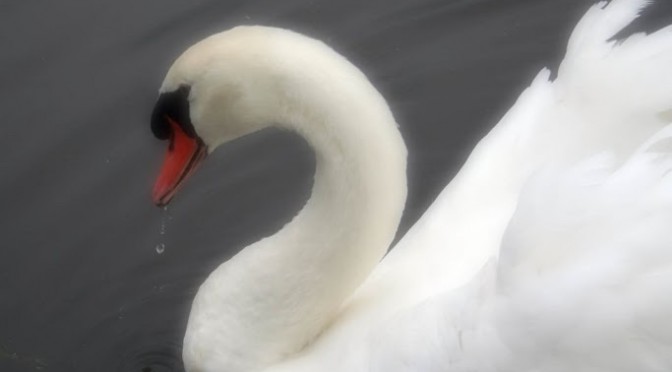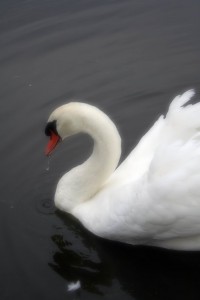I don’t know that this quote holds true for mute swans, but I do believe it to be true for most other things in the natural world. I think we’re more inclined to curiosity once some love and knowledge is gained, don’t you?
For all their beauty, mute swans are maligned by many for their aggressiveness. In many places their numbers have increased such that they are edging out native waterfowl and destroying aquatic vegetation. They are known to drive away least terns, skimmers, and native swans like the tundra from roosting and feeding areas.
The more you know about these elegant birds, the harder it is to look upon them as anything but pests. Like many other introduced or invasive species, the mute swan thrives, perhaps because of its great beauty, despite our knowing it so well.


Thanks for the lesson, Laura. Obviously, they are beautiful and perhaps their popularity relies on it. I didn’t know of their aggressiveness and destructive ways. Do I need more education on waterfowl? You bet, I do.
Hm. I think familiarity does breed contempt for starlings, house sparrows, and the like, which share invasive status with mute swans. But I do believe that familiarity breeds love and knowledge for most other species and natural phenomena. After all, without taking time to educate ourselves and become familiar, we would not have much opportunity to either love or hate them.
Mute swans are a mixed blessing. Although they are an invasive and agressive species, I always liked them very much at Wit’s End. There we had two pair, one on either end of the lake and they were calm and beautiful and comical once they hatched little ones in the Spring. And I didn’t mind their attitude much because they drove off the Canadian Geese who were messy,messy,messy- all over the dock, the yard, the boat…
I took lots of pictures of them because they were so lovely.
Call me naive or ignorant or worse, but I’ve neer been able to muster the intense negative feelings (dislike) of introduced/invasive species. They don’t plan or conspire to succeed, they just live. And like every other bird I’ve ever seen, they are beautiful.
I have a feeling I’m putting my neck out there on this one.
Lynne: You’re right, we’ve helped them along to do so well – they’re just doing their best to survive.
I don’t think you need to dislike or hate them, just be aware of the damage they do. And that needn’t get in the way of admiring their beauty.
In some places, like the Chesapeake Bay, they want to control mute swans and while I understand and agree with the science behind it, it’s still a little hard to accept some of the less humane control methods.
Vicki: The lesser of two evils, huh? Were they ever aggressive toward you?
John: Yes, it’s worse to be ignorant or uncaring.
Mary: Most people don’t know any different, Mary. I wonder too, how much of a local issue it is.
Oh yes, Laura – they’ve got the beauty thing going – big time. I had no idea, though, that they were problematic. There is a pair that’s drifted around on our local ponds for years and I’ve been a great admirer. Curiously though, they never have young.
They are quite beautiful, but like Cathy I had no idea they were such pests. Thanks for the lesson.
I know that certain birds that weren’t “native” cause problems such as House Sparrows, Starlings, Mute Swans etc.
We’re not native and cause some problems too.
I don’t buy the whole native thing. How is it we decide to pick and choose? Cardinals and Red-Bellied Woodpeckers weren’t native to the Northeast but moved their way up. We don’t have a problem with that. So if someone introduced those birds here would we have a problem?
Bringing Bluebirds back by putting up Bluebird trails to combat competition with other birds was a good thing.
I think that some of the birds that people don’t like such as Starlings, Blue Jays, and House Sparrows are now in decline. Nature has a way of doing what it wants.
I think we need to accept things as they are.If we feel we can do something to help a certain species we like that we can go ahead and do that.(I’m not really as angry as I sound-just an opinion).
I had no idea about mute swans… interesting. But you are right in that because they are elegant birds, their beauty tends to instill more love than contempt.
You have raised a difficult issue.
Thanks for all the ideas to think on…
I think with the invasive species it’s because they aren’t natural that familiarity allows contempt to creep in. They are unnatural and they disrupt the balance of nature in the areas they invade.
I’m glad you’re addressing this topic, because it’s one that I’ve struggled with as a beginning birder. I’m with Lynne–these birds didn’t introduce themselves; humans did it. If the same happened to me, I know I’d try my best to survive. I realize they’re hurting native species, but it’s hard for me to dislike these creatures. Still, I’ve seen sites where they’re villified and people will go to all sorts of crazy and often cruel measures to stop the “invasion.” That can’t be right, can it?
Beautiful shot, Laura, and thanks for the information. There has to be a way for everything to survive, after all most people living in the US, are not native to this country.
You posted a sticky wicket, didn’t you Laura?
My love of something is not limited to its beauty, and I strive to find a balance when I see a bird like a mute swan.
Can I admire it and wish it dead in the same thought?
I would love to write on and on about this one, but I have to go bag dead rats.
Wish it back to Eurasia.
Cathy: They know they’re pretty too. Do you see any other ducks on the local ponds?
Laurie: I don’t know, maybe just a local issue.
Larry: Maybe then I’ve framed the issue incorrectly; perhaps we should say the problem stems not from their not being native, but instead because they are invasive in some areas. I’d say also that we humans have the same issue.
The idea is that some species are better able to compete and thus become invasive. You or I are able to see that at our backyard feeders – the red-bellies don’t arrive by the hundreds and scare the other birds away, do they? Bluebirds don’t bury the nests of chickadees. Some native species are problematic too – think of house wrens or cowbirds.
I will differ with you on the idea that we should accept things as they are. I don’t believe that. I think we should bear responsibility for the environmental problems we’ve helped to create, whether by introducing species or fragmenting natural habitat.
Jayne: Right, it’s hard not to like something so pretty.
Endment: I think I hear you laughing – there’s a reason I hadn’t posted this photo I took months ago!
Liza: Balance – yes! Well put.
Delia: I don’t know the answer. But I don’t think we should just throw our arms up because we made the problem to begin with, you know? It’s a lot easier to talk about the issue of non-natives/invasive species when you’re thinking of plants. Maybe I should have saved the discussion for a time when I had a photo of multiflora rose or honeysuckle.
Sandy: Did you see the drop of water from its bill and the pretty ripples it made in the water? Or the little loose feather just floating there?
Don’t you think we’re invasive?
Susan: Happy ratting. Shouldn’t YOU be discussing this sticky-wicket on YOUR native blog?
lol! Honest I just had this picture that needn’t some text!
FC: You’re the science teacher. Help me out here.
Dang! I think you’re right. Rarely do we see other ducks on those ponds.
Sooo . . they’re driving them off. Ouch.
This comment has been removed by the author.
I agree that we should do what we can to manage problems we have created. My main point was that one bird isn’t better than another just because they are less common.(half of the babble I wrote was on my way out to work).
The core cause of most of our enviromental problems is probably overpopulation.
Laura,
You are darn right, we are invasive!
Or this would be The United States of Native America